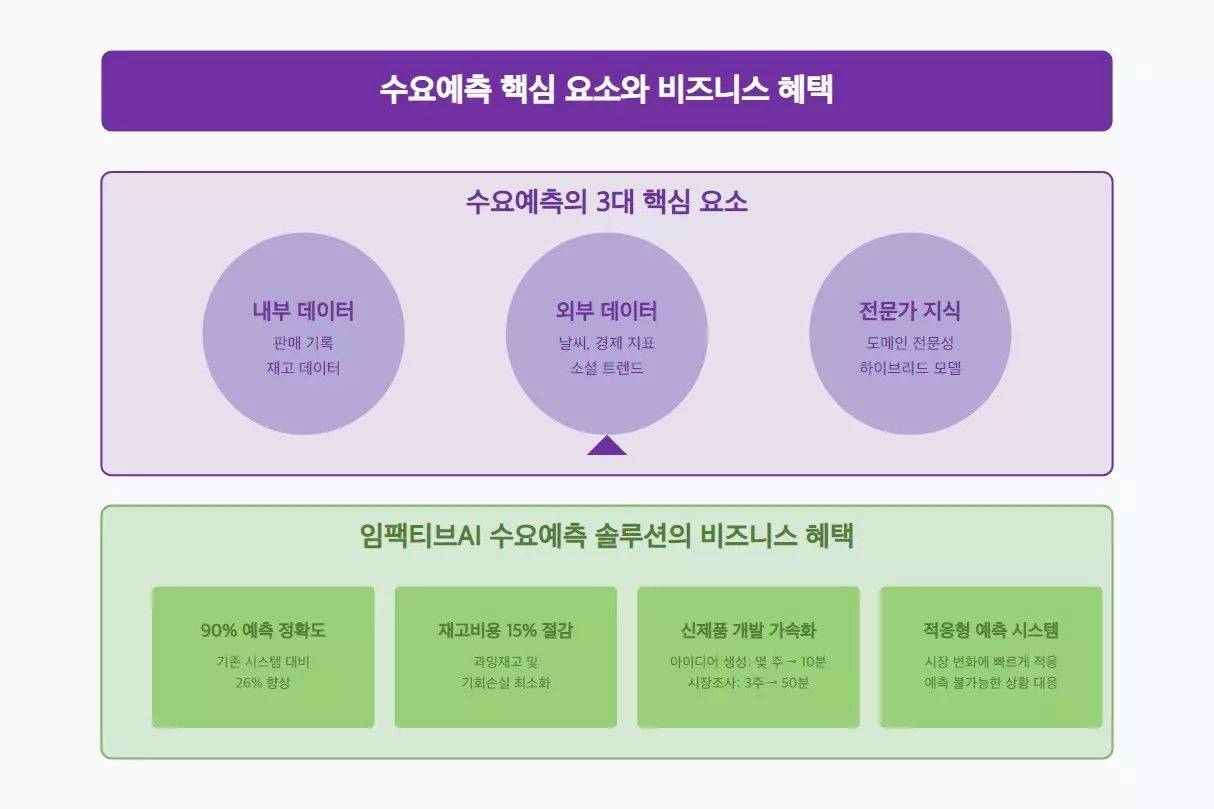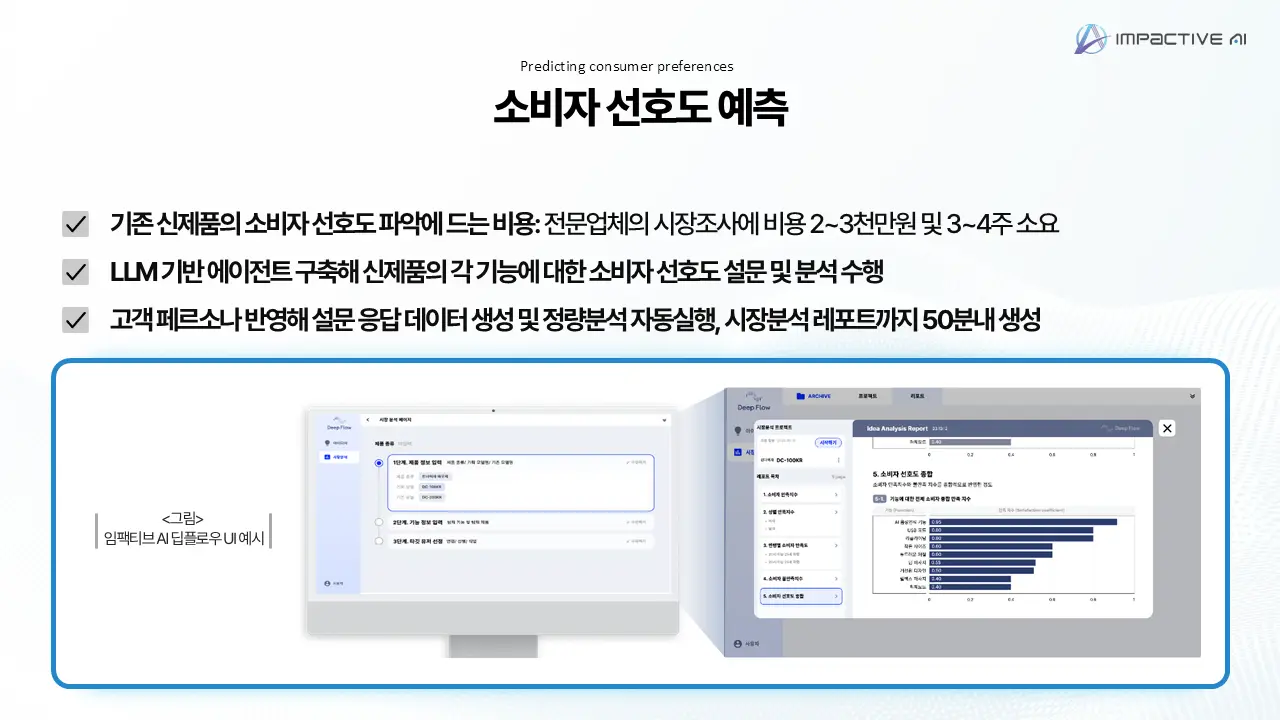
Demand forecasting is a core element for efficient operation and growth of companies, but many small and medium enterprises hesitate to adopt it due to data shortage and lack of specialized personnel. Particularly when past data is insufficient or when data formats are diverse and unstructured, building accurate prediction models can feel even more challenging.
Recent advances in artificial intelligence (AI) technology overcome these constraints and enable effective demand forecasting even in situations with insufficient data. This article introduces strategies for successful demand forecasting adoption by small and medium enterprises and ImpactiveAI's expertise, focusing on data augmentation, a key technology that solves data shortage problems.

Augmented data is a core strategy that can achieve high-level prediction performance even in limited data environments. This method is effective for the following reasons:
First, increased data volume improves statistical stability. Prediction models perform better with more training data, but collecting large amounts of data in real environments requires significant time and cost. Data augmentation solves this problem by transforming existing data to slightly change time sequences or make small modifications to generate new data with characteristics similar to but different from the original.
Second, augmented data enables models to learn various situations. In sales data analysis, when various situations such as holidays or special events are generated as augmented data, models can respond more effectively to these situations in real environments.
Third, augmented data prevents overfitting. Overfitting is a phenomenon where models adapt excessively to training data, resulting in degraded prediction performance for new data. Augmented data increases data variability and diversity, inducing models to learn more generalized patterns, enabling better response to new data.
Fourth, model robustness improves. Through augmented data, models become accustomed to various noise and variations, enabling relatively accurate predictions even during sudden market changes or unexpected events.
Additionally, increased data volume has significance beyond simple diversity. From a statistical stability perspective, as data volume increases, estimates of statistical characteristics like mean and variance become more accurate, and samples better represent the entire population. This helps models understand and learn the actual distribution of data more accurately.

Data augmentation is a technique that artificially increases limited amounts of data to improve learning model performance, particularly presenting possibilities for small and medium enterprises with insufficient data to build demand forecasting systems. Various data augmentation methods must be applied considering characteristics of time series data, and each methodology has unique advantages, disadvantages, and application scenarios.
In demand forecasting dealing with time series data, one traditional technique for data augmentation is the sliding window technique. This method divides time series data into fixed-length segments to generate training data. However, when segments overlap, high correlation between data can impede model generalization performance.
Time shifting techniques generate new data by moving time series data and help learn trends and seasonality, but large shift widths can cause temporal order distortion, leading to decreased prediction accuracy. Noise addition techniques add artificial noise to time series data to increase model robustness, but careful consideration is needed in determining noise types and magnitudes.
Recently, synthetic data generation techniques using generative models like GAN, VAE, and Diffusion Models are being applied to demand forecasting. GANs are strong at generating data similar to reality but can have unstable training, while VAEs effectively generate various data transformations using latent spaces.
These data augmentation techniques can be used individually or combined through ensemble methods for better results. What's important is recognizing problems that can occur during data augmentation processes and establishing strategies to solve them.
For improving demand forecasting accuracy, utilizing various external data along with internal data is important. Weather, economic indicators, social media trends, and search term data reflect consumer behavior changes and market conditions, reducing prediction uncertainty.
For effective external data utilization, preprocessing processes such as unifying data formats and units and temporal alignment are necessary, and accuracy, consistency, and timeliness must be continuously managed for data quality. Above all, analyzing correlations with internal data and selectively utilizing only variables meaningful for actual prediction is key to successful data integration.
In data-scarce environments, expert knowledge is crucial for improving demand forecasting model performance. Experts identify major influencing factors based on field experience and compensate for data shortage. They help design model structures and adjust parameters, providing validity evaluation and interpretation of prediction results to support better decision-making.
Methods for utilizing expert knowledge include interviews, surveys, Delphi techniques, fuzzy theory, and decision trees. Recently, methods using LLMs to quickly obtain expert opinions generated based on market data are also being attempted.
Hybrid approaches combining expert knowledge with data-based models increase prediction accuracy by utilizing variables selected by experts or using expert predictions as model inputs.
Demand forecasting is core competitiveness in modern business, but many companies struggle with securing sufficient data. This problem is particularly serious for small and medium enterprises. ImpactiveAI has developed innovative technology solutions to solve these challenges.
To optimize prediction model performance in limited data environments, ImpactiveAI has implemented multi-layered data augmentation technology. This technology stack secures data diversity for model training while preserving characteristics of time series data.
Sliding window techniques divide time series data into fixed-length segments to expand training data. Our system optimizes window size and step size according to data characteristics to minimize correlation distortion. This significantly reduces overfitting problems occurring in existing prediction models.
Time shifting techniques generate new sequences while maintaining temporal patterns in data. Optimal shift widths are determined through autocorrelation analysis to effectively capture seasonality and trends in time series. This improves model adaptability to various market conditions.

Generative model-based synthetic data generation is the most innovative aspect of our solution. Through hybrid approaches combining GANs, VAEs, and Diffusion Models, statistically meaningful synthetic data is generated. This technology is particularly effective for generating data about extreme market conditions or rare events.
ImpactiveAI's demand forecasting engine consists of over 200 prediction models optimized for various data characteristics and market conditions.
Ensemble prediction modeling combines various algorithms including general machine learning like XGBoost and QBoost as well as deep learning and transformers to overcome limitations of single models. Quantile decomposition based Regressor effectively models uncertainty through predictions considering various quantiles rather than mean value predictions sensitive to outliers.
The differentiation index system utilizes 36 unique variables to quantify differentiation factors between products. It analyzes market competitiveness from various aspects including overall differentiation index, functional specification differentiation index, and medical certification differentiation index. This system more accurately predicts expected sales volumes for new products compared to existing products.
The market environment indicator module integrates and analyzes 1,375 economic, consumer, and industry-related variables. It significantly improves prediction accuracy by reflecting extensive external factors from weather data to economic indices and consumer sentiment indices in models. Particularly, ImpactiveAI's proprietary variable selection algorithm automatically identifies the most influential indicators for each product category.
ImpactiveAI has built a generative AI system that innovates the new product development process itself. The idea generation engine generates over 100 new product ideas within one hour based on various innovation options. The AI agent survey system provides feedback on new product concepts from AI agents with various personas, generating analysis reports predicting market reactions within 5 minutes.

ImpactiveAI's demand forecasting solution leads the market with unparalleled accuracy. It shows superior prediction performance (90% accuracy based on 100-MAPE%) compared to advanced IT services, which is significantly higher than existing statistical methods (64%) or general machine learning models (87%). This accuracy improvement directly translates to minimizing excess inventory and opportunity losses in actual business environments.
Traditional approaches required considerable time and costs for new product development and market research. ImpactiveAI's solution innovatively shortens this process. Idea generation completes processes that previously took weeks within 10 minutes, and market research compresses work that took over 3 weeks into 50 minutes.
Another strength of ImpactiveAI's solution is excellent scalability and adaptability. Even with limited initial data, prediction models gradually improve through continuous learning. This is confirmed by the expansion from 100 models in 2022 to 200 in 2023. Additionally, even in unpredictable situations like COVID-19, models have capabilities to quickly learn and adapt to new patterns.
ImpactiveAI is not satisfied with current technological achievements and aims to evolve toward more precise and predictive AI technology.
The message we want to emphasize most to companies hesitating to adopt demand forecasting AI due to data shortage problems is clear: Data shortage can no longer be a barrier to AI innovation. ImpactiveAI's technological innovation is designed to fundamentally solve these limitations.
Until now, many companies have delayed AI adoption when sufficient data was not secured. However, ImpactiveAI's data augmentation technology and advanced prediction algorithms fundamentally change these constraints.
Particularly as verified solutions across various industries including manufacturing, retail, and consumer goods, they are optimized to work effectively even in small and medium enterprise data environments.
We deeply understand that AI technology adoption should be approached from business innovation perspectives rather than simple technical issues. ImpactiveAI supports companies' digital transformation journeys through the following step-by-step approaches:
This approach provides opportunities to confirm clear ROI while minimizing initial investment burden.
If you're hesitating to adopt AI due to data shortage problems, ImpactiveAI provides practical starting points. You can begin with free data diagnosis consulting services that accurately assess current data status and evaluate potential.
This is followed by customized data augmentation workshops that strengthen data utilization capabilities by providing practical methodologies maximizing existing corporate data.
Finally, single product group pilot projects that can confirm concrete results within 4 weeks verify the practical value of AI technology.
Future market competitiveness depends on accurate prediction and agile response capabilities even amid uncertainty. How data is utilized, not the size of data, will be the measure of success. We hope you will open a new era of data-driven decision-making together with ImpactiveAI.
